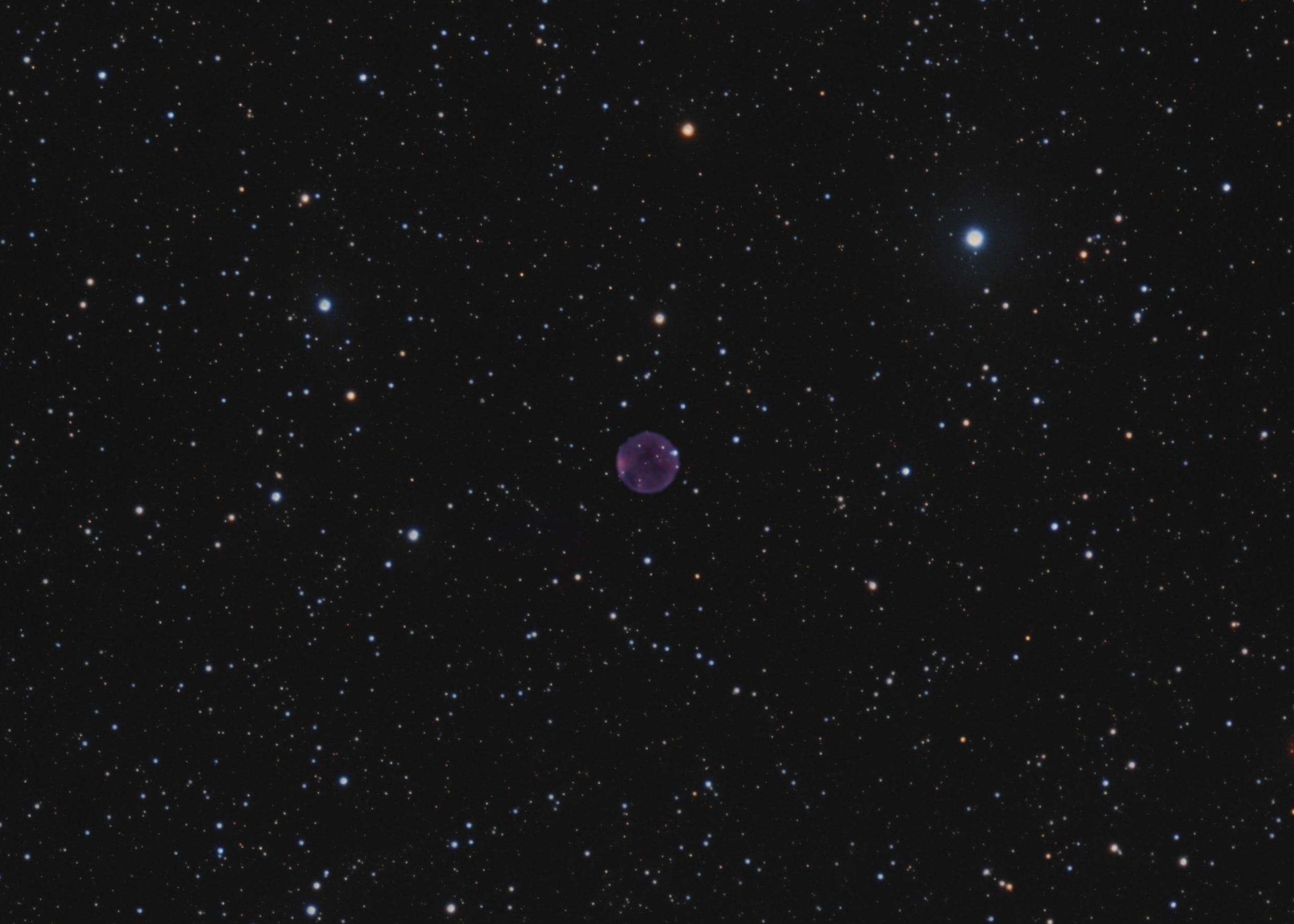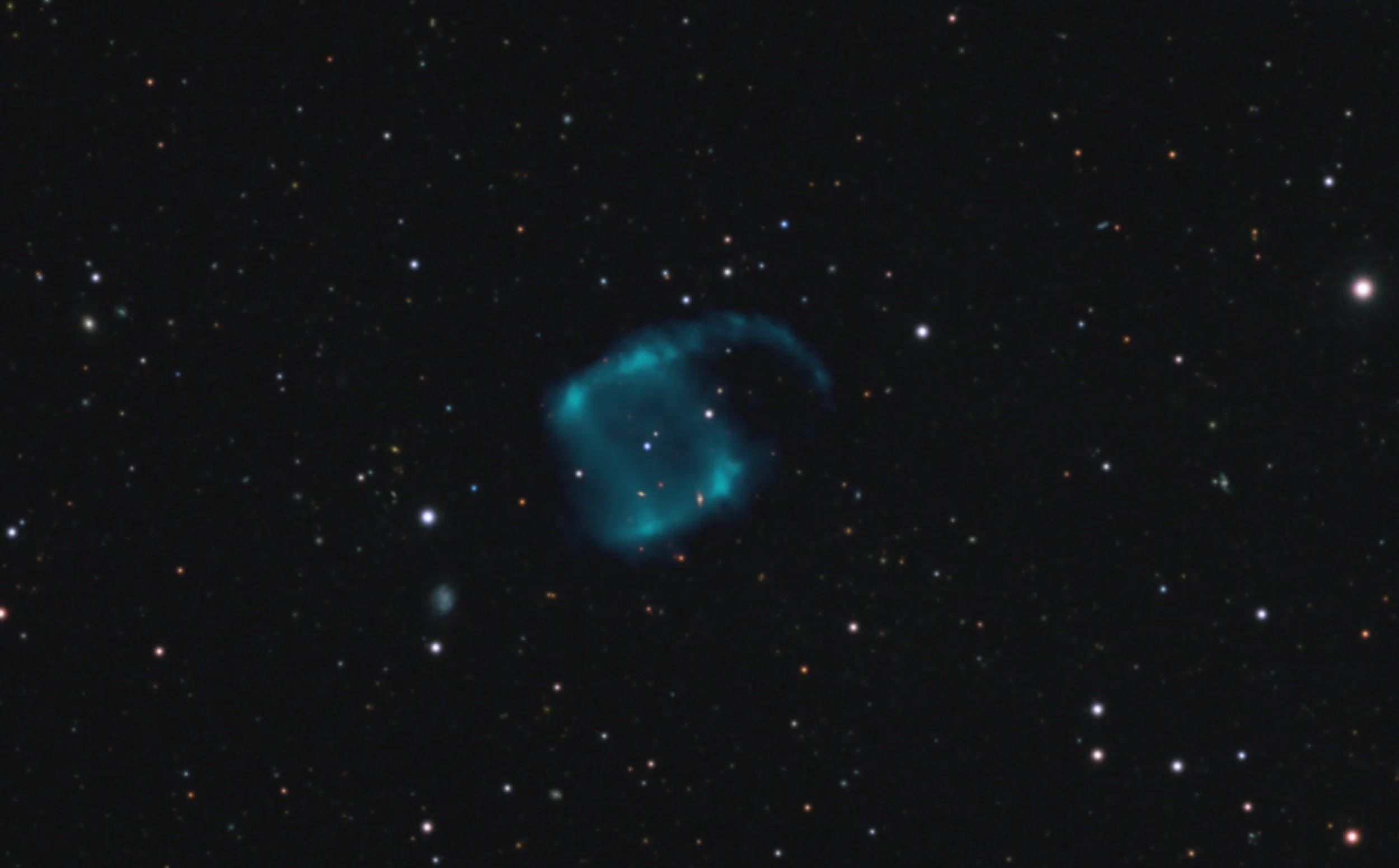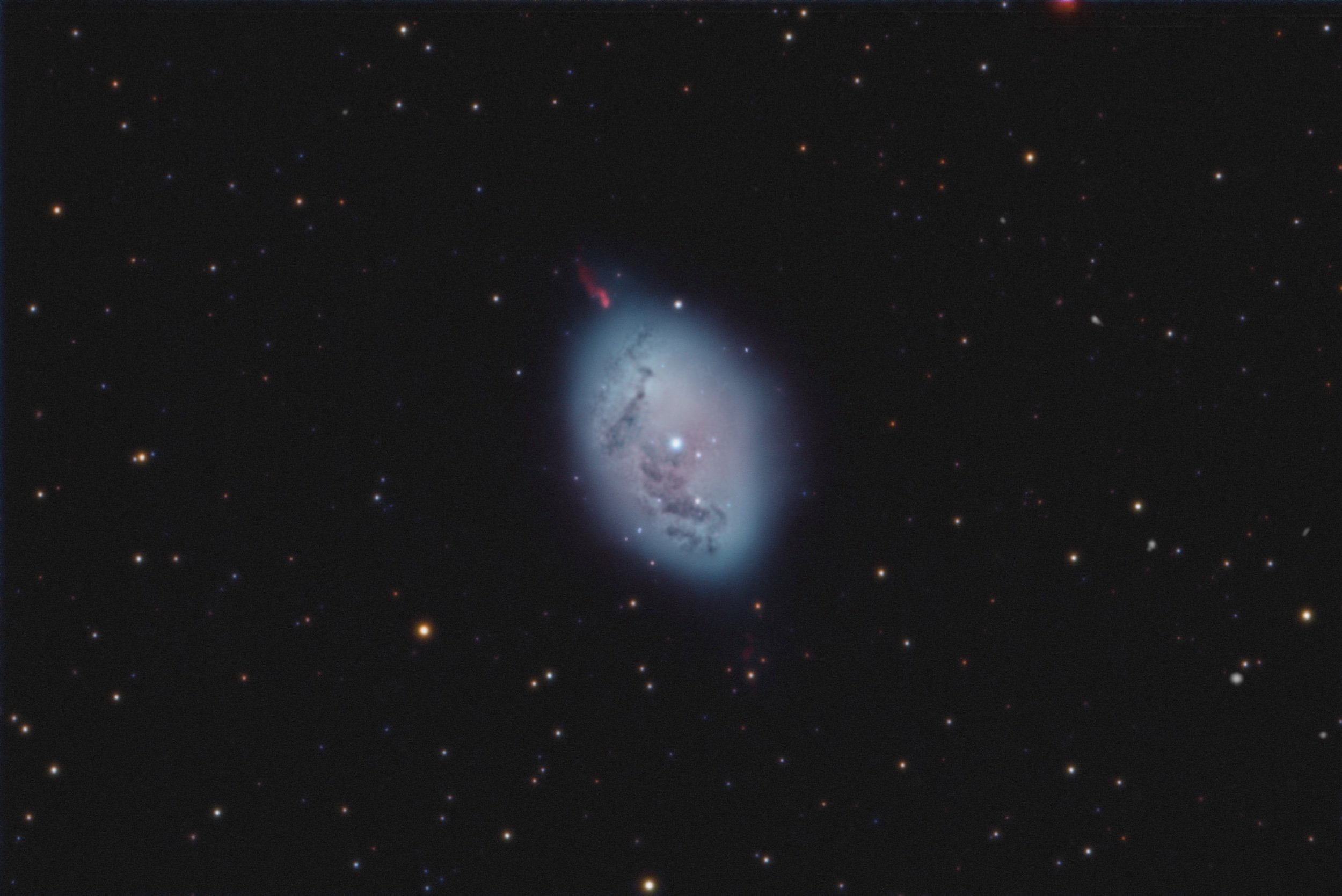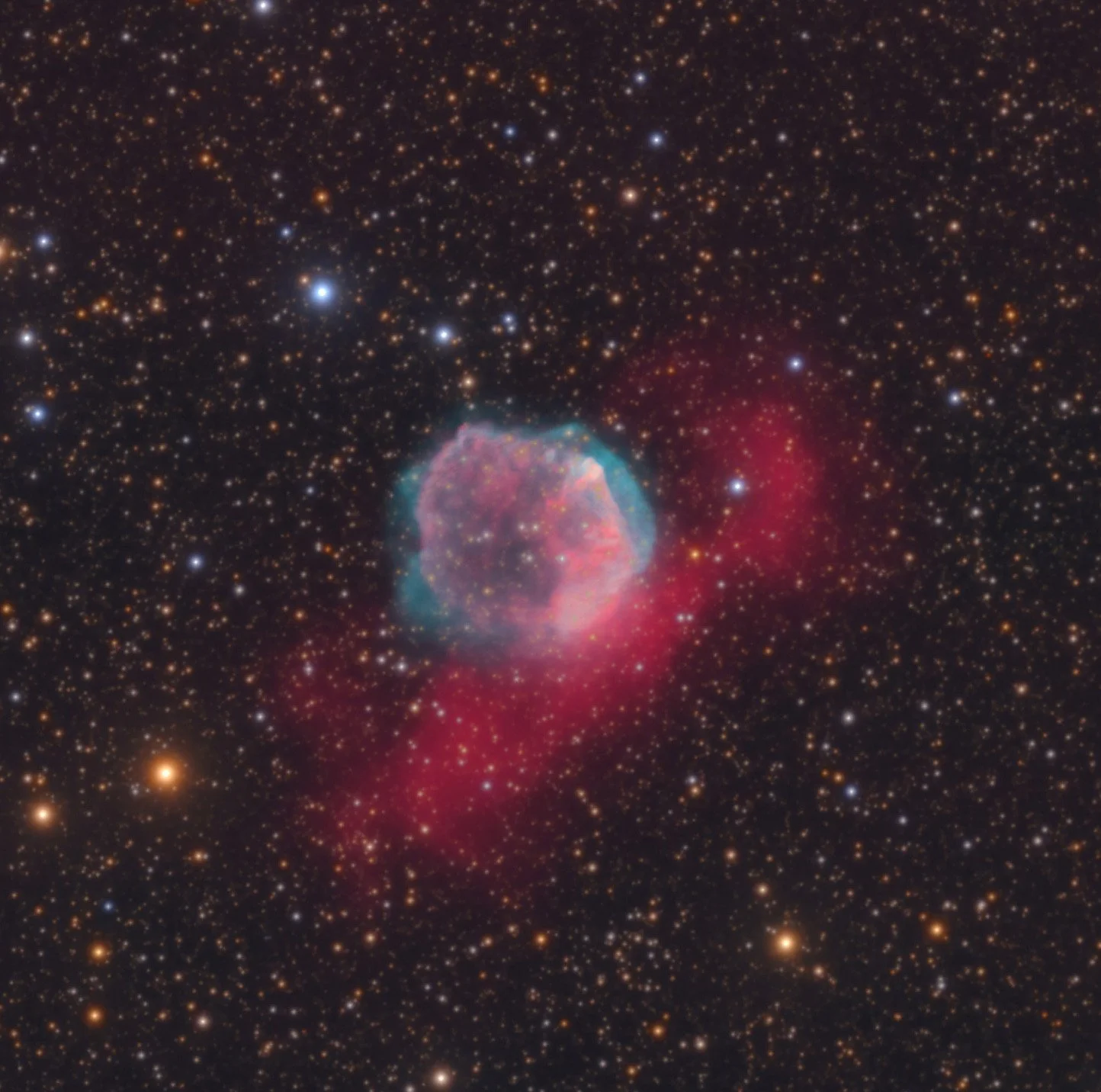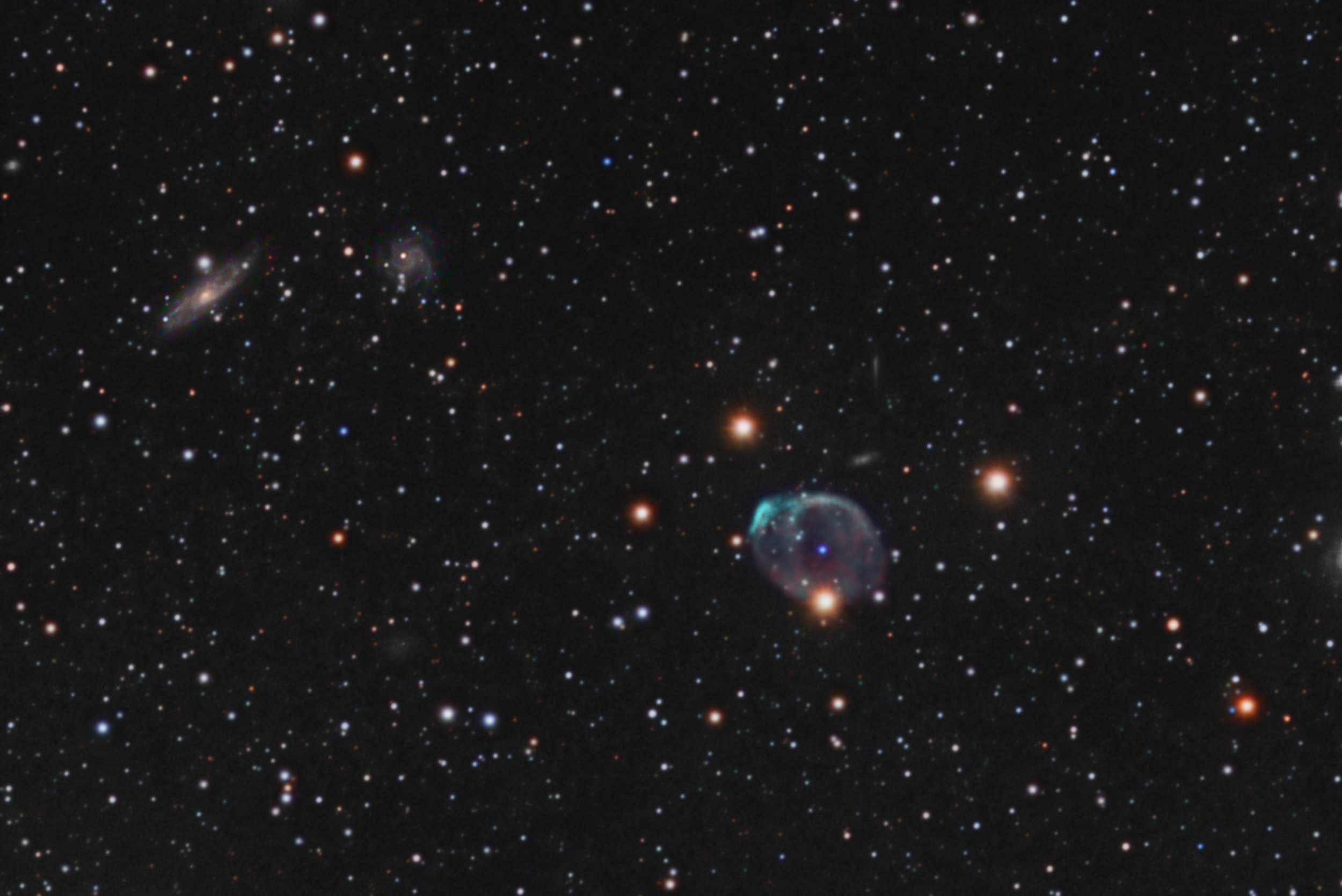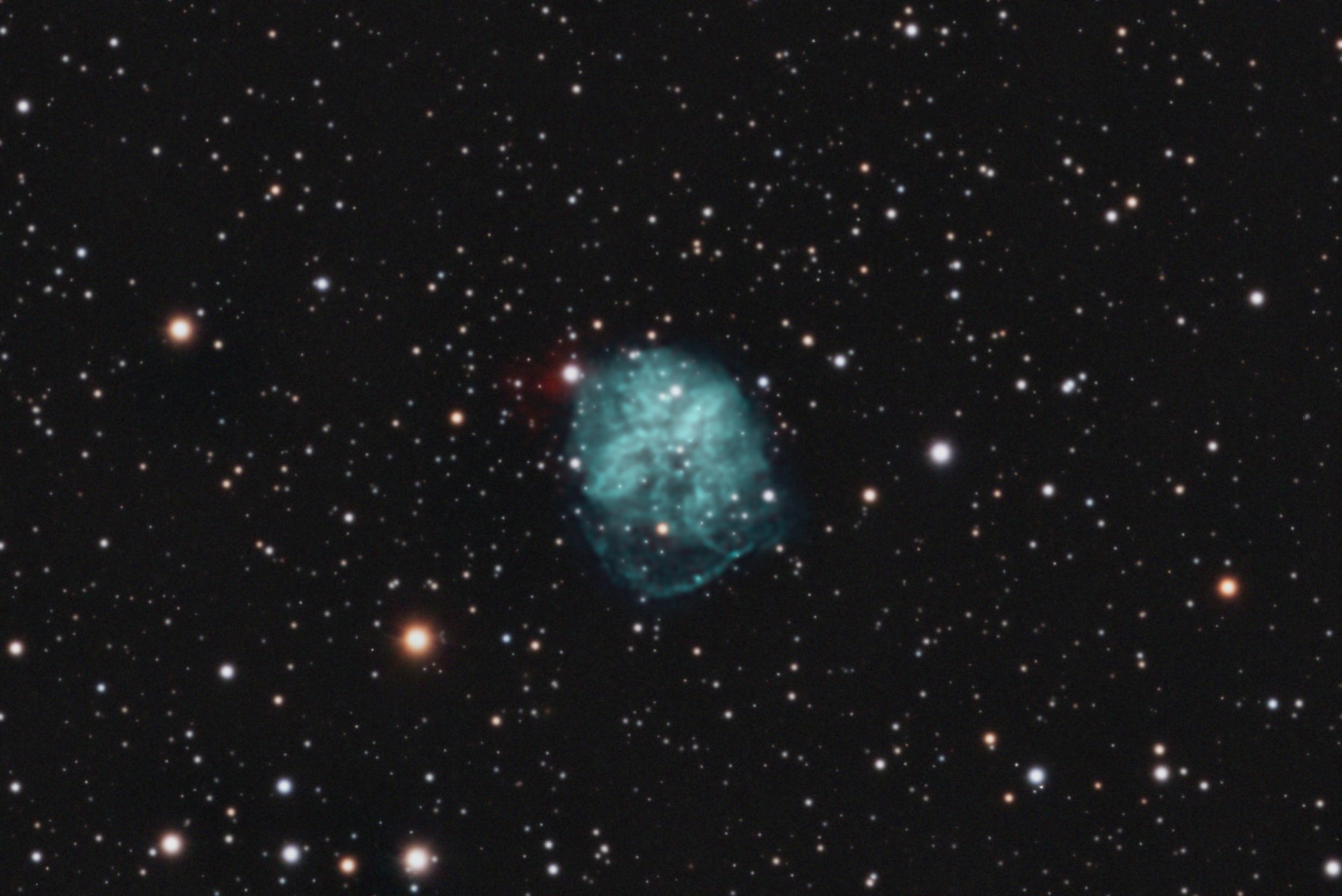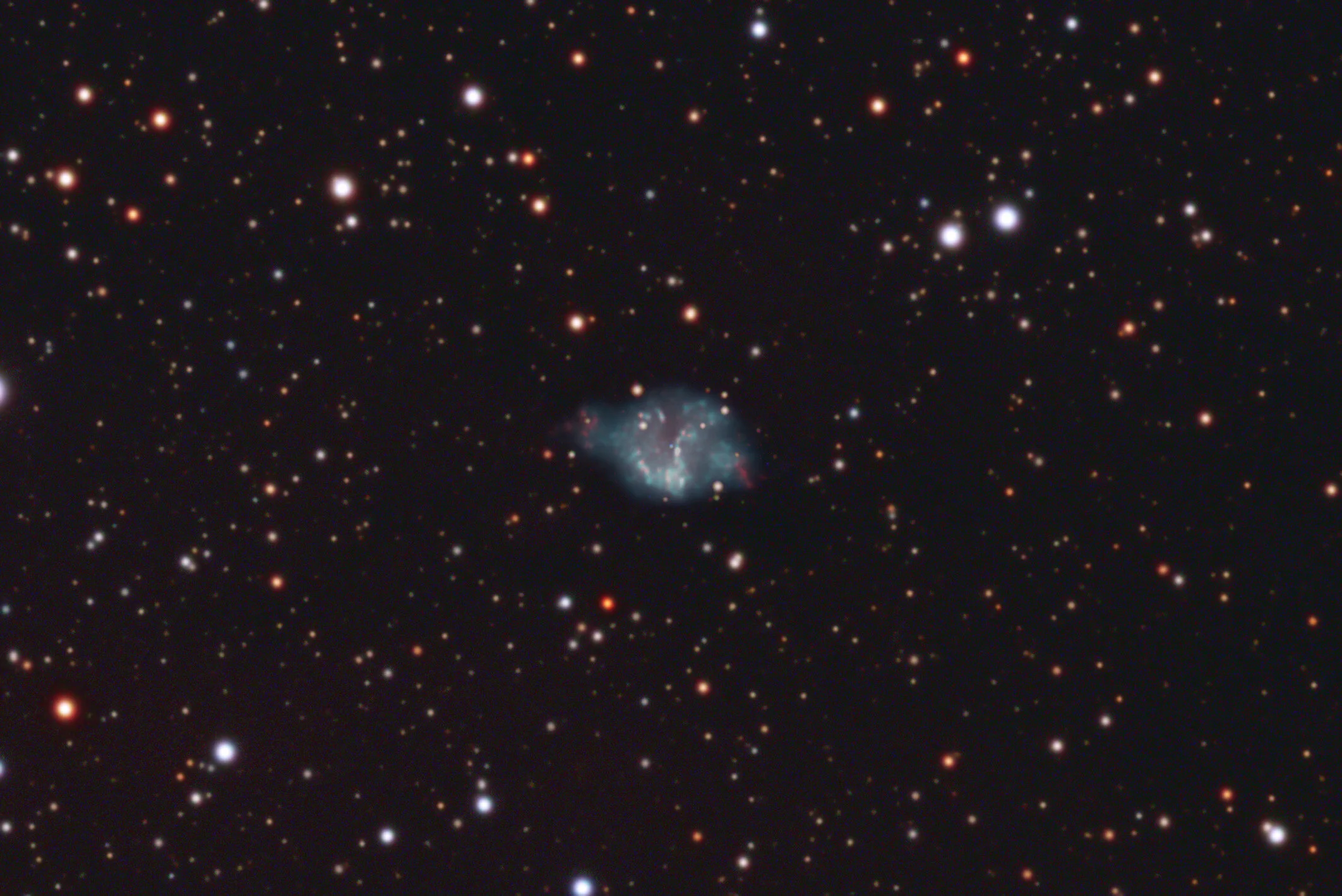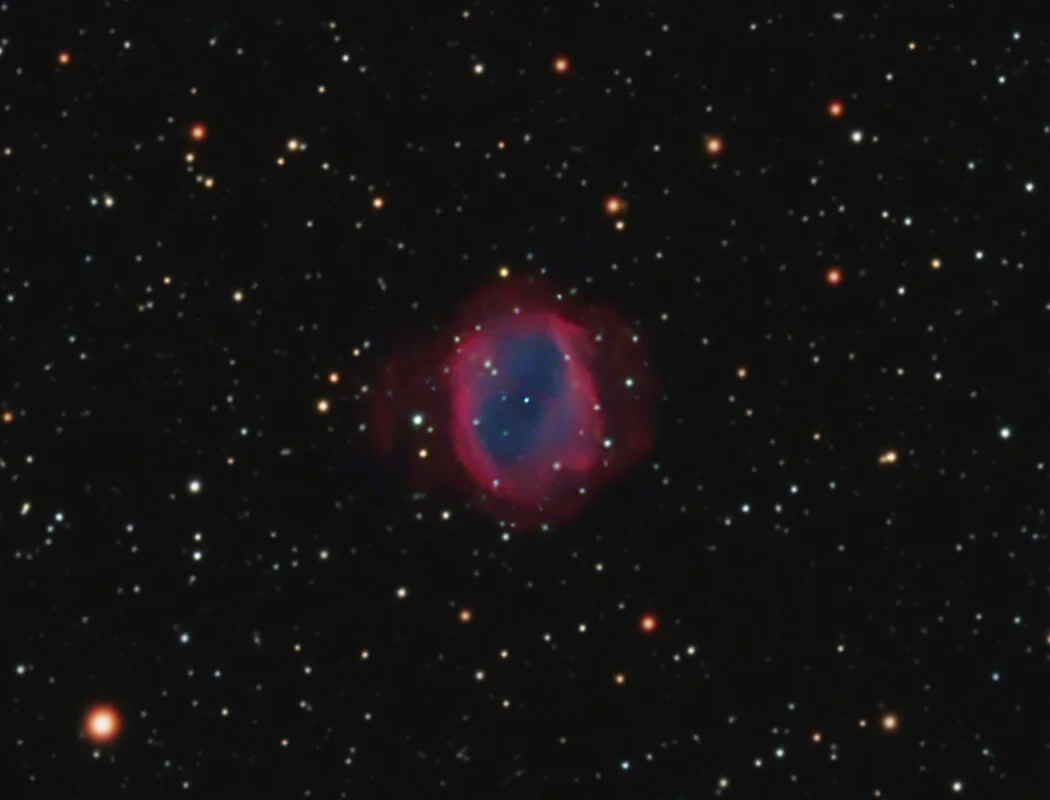
AAPOD2 Image Archives
Abell 34
Abell 34 is a large, faint planetary nebula located in the constellation Hydra. It exhibits a distinct, nearly spherical structure with a characteristic bluish-green hue due to ionized oxygen (OIII) emissions. This evolved nebula represents the final stages of a dying star shedding its outer layers, leaving behind a hot white dwarf at its core.
Captured from Fregenal de la Sierra, Spain, this deep-sky image required long integration times to reveal the nebula’s delicate structure against the background sky. Its low surface brightness makes it a challenging target, requiring precise calibration and processing to enhance its faint details while preserving the surrounding field of stars.
M 2-55 and its elusive fragmented bow-shock front
Image Description and Details: M 2-55 is an evolved rarely-imaged planetary nebula in the constellation Cepheus. It was first discovered and identified by the German-American astronomer Rudolph Minkowski on photographic plates at Mount Wilson in 1947. The plates were taken by W.C. Miller with a 10" f/5.2 refractor.
IM 2-55 possesses two sets of bipolar lobes.
It was only in 2020 that a team of Chinese professional astronomers detected an arc of material running from the SE to the SSW. (Chih-Hao Hsia et. al, March 13th 2020, “Discovery of Extended Structures around Two Evolved Planetary Nebulae M 2-55 and Abell 2”). They concluded that this arc was furnishing strong evidence for an interaction of the expanding nebula of \m 2-55 with its surrounding interstellar material. The presence of fragmentation in the arc may be the result of a phenomenon known as Rayleigh-Taylor (RT) instabilities.
A total of 115 hours HaOIIIRGB image capture
First image of planetary nebula Si 1-2
Observations of Si 1-2 and other planetary nebulae contribute to our understanding of stellar evolution, as well as the recycling of material within galaxies. The intricate shapes and structures of these nebulae showcase the dynamic interplay between stars and the cosmos, reminding us of the ongoing cycles of creation and destruction that shape the universe.
NGC 1514
Image Description and Details : NGC 1514 is a planetary nebula in the constellation Taurus. It is also known as the Crystal Ball Nebula. It is 1520 light years from Earth. The nebula originated from a binary star system with the designation HD 281679 from the Henry Draper Catalogue. The bright, visible component is a giant star, while the nebula-generating companion is now a hot, sub-luminous O-type star. The two have one of the longest known orbits for any planetary nebula, with a period of about 9 years.
Captured on my remote observatory in Spain.
Scopes: APM TMB LZOS 152 Refractors
Cameras: QSI6120wsg8
Mounts: 10Micron GM2000 HPS
A total of 35 hours (HaOIIIRGB)
Copyright: Copyright: Peter Goodhew
Ltnf 1
Image Description and Details : LTNF 1 is an extremely faint and rarely-imaged highly-evolved planetary nebula in the constellation Ursa Major. It is a high-excitation nebula with an eclipsing binary star system (BE Ursae Majoris) at its centre which has resulted in its unusual morphology. It is around 5,000 light years from Earth. It is so transparent that galaxies can be seen through it. It was discovered by James Liebert, Richard Tweedy, Ralf Napiwotzki and Michael Fulbright in 1995. A joint project with Sven Eklund.
Scopes: APM TMB LZOS 152 Refractors and Celestron C14 Edge HD
Cameras: QSI6120wsg8 and ZWO ASI6200MM Pro
Mounts: 10Micron GM2000 HPS and 10Micron GM3000 HPS
A total of 73 hours 25 minutes (OIIILRGB)
Copyright: Copyright: Peter Goodhew, Sven Eklund
NGC 1360
Image Description and Details : NGC 1360, also known as the Robin's Egg Nebula, is a planetary nebula in the Fornax constellation. It is estimated to be between 1200 and 1800 light years from Earth.
Scopes: APM TMB LZOS 152 Refractors and Celestron C14 Edge HD
Cameras: QSI6120wsg8 and ZWO ASI6200MM Pro
Mounts: 10Micron GM2000 HPS and 10Micron GM3000 HPS
A total of 35 hours 30 minutes (HaOIIIRGB)
More information at
Copyright: Copyright: Peter Goodhew, Sven Eklund
Strottner-Drechsler 16
Image Description and Details : NEW DISCOVERY: Strottner-Drechsler 16 is a new candidate of a planetary nebula in the constellation Aquila. It was discovered by the German-French team of Marcel Drechsler and Xavier Strottner in 2020 and has the catalogue designation StDr 16 / PNG 039.1-04.5. This photo, taken in collaboration with Sven Eklund from Sweden and processed by Marcel Drechsler from Germany, is the first ever taken of this faint object. Typical for planetary nebulae is a compact envelope of H-alpha and OIII surrounding a tiny white dwarf. Coordinates: 19:18:50.58 + 03:27:20.82 Constellation: Aquila Size: 2.4 arcminutes This was a joint data capture project with my good friend Sven Eklund, with data captured on both my dual rig of 6" refractors and his C14 EdgeHD - all located at Fregenal de la Sierra in Southern Spain. Data captured between 21-26 June 2022. Scopes: APM TMB LZOS 152 Refractors and Celestron C14 Edge HD Cameras: QSI6120wsg8 and ZWO ASI1600MM Pro Mounts: 10Micron GM2000 HPS and iOptron CEM120 A total of 103 hours 25 minutes (HaOIIIRGB)
Copyright: Copyright: Peter Goodhew, Sven Eklund, Marcel Drechsler, Xavier Strottner
Abell 71
Image Description and Details : Abell 71 is a faint planetary nebula in the constellation Cygnus. It has a diameter of 168 arc seconds and is 2,400 light years from Earth. The background nebulosity is part of SH2-116. This was a joint project with my good friend Sven Eklund, with data captured on both my dual rig of 6" refractors and his C14 EdgeHD - all located at Fregenal de la Sierra in Southern Spain. Data captured between 7-21 June 2022. Scopes: APM TMB LZOS 152 Refractors and Celestron C14 Edge HD Cameras: QSI6120wsg8 and ZWO ASI1600MM Pro Mounts: 10Micron GM2000 HPS and iOptron CEM120 A total of 51 hours 30 minutes (HaOIIIRGB)
Copyright: : Peter Goodhew
DeHt 2
Image Description and Details : DeHt 2 is a faint (mag 14.9) planetary nebula in Ophiuchus. It is estimated to be 6000 to 10,000 light years from Earth. It was discovered in 1979 by J. Dengel, H. Hartl and R. Weinberger. The mag 13.5 spiral galaxy at upper left is UGC10943, located about 115 million light years away. Image captured on my remote dual rig at Fregenal de la Sierra in Spain between 13 May - 8 June 2022. Scopes: APM TMB LZOS 152 Refractors Cameras: QSI6120wsg8 Mounts: 10Micron GM2000 HPS A total of 68 hours 30 minutes (HaOIIILRGB)
Copyright: Peter Goodhew
Kohoutek 1-6
Image Description and Details :
Kohoutek 1-6 (K 1-6) is an evolved low-surface brightness planetary nebula in the constellation Draco. It is an asymmetric planetary nebula with a binary central star. It has an approximate size of 198 arc seconds and is around 3,000 light years from Earth. It was discovered by Czech astronomer Luboš Kohoutek in 1962. It has a bow-shock structure which is attributed to interaction with the interstellar medium (ISM).I could only find one other image of this online - captured by the Capella Observatory in 2019. Image captured on my remote dual rig at Fregenal de la Sierra in Spain between 20 April and 3 May 2022.Scopes: APM TMB LZOS 152 RefractorsCameras: QSI6120wsg8Mounts: 10Micron GM2000 HPSA total of 56 hours 45 minutes image capture (HaOIIIRGB)
Copyright: Peter Goodhew
An Owl with a Halo
Image Description and Details : Messier 97 - a planetary nebula in Ursa Major sporting its faint OIII Halo. It is approximately 2,030 light years from Earth.
I was pleased to be able to tease out some of the structure of the faint outer OIII halo - especially as most of the OIII data was captured from my Bortle 8 sky in London because Spain has been clouded out for the past month.
Image captured on my remote dual rig at Fregenal de la Sierra in Spain and my C11 telescope in London between 14 January - 24 March 2022.
Scopes: APM TMB LZOS 152 Refractors, C11 reflector
Cameras: QSI6120wsg8, QSI683wsg8
Mounts: 10Micron GM2000 HPS, 10 Micron GM1000 HPS
A total of 48 hours 55 minutes image capture (HaOIIILRGB)
Copyright: Peter Goodhew
Abell 31
Image Description and Details : Abell 31
An evolved planetary nebula in the constellation Cancer. It is estimated to be 2,000 light years from Earth.
TARGET
Nomenclature: Abell 31
Right Ascension: 08:54:13.20
Declination: +08.53.53.02
Size: 970 arc secs
EQUIPMENT USED
Twin APM TMB LZOS 152 refractors
10Micron GM2000 HPS mount
Twin QSI6120 CCD cameras
Astrodon filters
IMAGE CAPTURE
Blue: 10x300"
Green: 24x300"
Red: 27x300"
Ha: 76x900" bin 1x1
OIII: 76x900" bin 1x1
Total Integration: 43 hours 5 minutes
Pixel scale: 0.531 arcsec/pixel
Field radius: 0.357 degrees
Capture dates: 28 February - 9 March 2022
Capture location: Fregenal de la Sierra, Spain
IMAGE PROCESSING:
CCDStack2 and Photoshop CS2
Copyright: Peter Goodhew
K2-1
Image Description and Details :
K2-1
A very faint and obscure planetary nebula some 3700 light years away in the constellation Auriga.
Initially catalogued as a planetary nebula, was later thought to be misclassified and considered to be either a reflection nebula (LBN 809), an H-II region, and even a galaxy (PGC 16765). However it has recently been rediscovered as a genuine planetary nebula. It has a size of 115x126 arc seconds and is predominantly OIII. The weaker Ha signal has a similar form to the OIII signal. However there's an odd small area of red nebulosity at the top left-hand corner. This is possibly some NII emission which would be captured by the 5nm bandwith of my Ha filter (the spectrum shows that NII is present).
Discovered by Czech astronomer Dr. Luboš Kohoutek in 1962 by visually examining the National Geographic Society-Palomar Observatory Sky Survey prints at the Astronomical Institute in Prague, Czech Republic
It has a mean surface brightness of 24.1 mag/arc sec.
Image captured on my remote dual rig at Fregenal de la Sierra in Spain between 19-23 February 2022.
Scopes: APM TMB LZOS 152 Refractors
Cameras: QSI6120wsg8
Mount: 10Micron GM2000 HPS
A total of 37 hours image capture (HaOIIIRGB)
Copyright: Peter Goodhew
PM1-333
Image Description and Details : PM1-333 is a small (70 arc seconds) planetary nebula in the constellation Cepheus. It was discovered by Andrea Preite-Martinez in 1988. I believe this to be the deepest, and highest resolution colour image of this target. The tiny blue progenitor star can just be made out dead centre of the image.
It lies within IC1396 where it appears as a small dot at the bottom left hand corner in J-P Metsavainio's excellent image https://1.bp.blogspot.com/-JEMi-QvpB0Q/XicHMRDQXbI/AAAAAAAARug/ECBNZGRTptwRSAOExQSKmmvCIZWz6niCACLcBGAsYHQ/s1600/IC1396Det.jpg
Image captured on my remote dual rig at Fregenal de la Sierra in Spain between 20-30 September 2021.
Scopes: APM TMB LZOS 152 Refractors
Cameras: QSI6120wsg8
Mount: 10Micron GM2000 HPS
A total of 54 hours image capture (HaOIIILRGB)
Copyright: Peter Goodhew
PM1-320
PM1-320 is a small planetary nebula in Cygnus, close to DWB 111, the Propeller Nebula.
It was discovered by Andrea Preite-Martinez in the 1980s.
I believe this to be the first deep high-resolution image of PM1-320.
The outer parts of the nebulosity are very faint, hence 56 hours of OIII integration.
HASH records it's size as 60 arc seconds.
TARGET
Nomenclature: PM1-320
Right Ascension: 20:10:33.6
Declination: +44:11:48.48
Size: 60.0 arc sec
Discovery: Andrea Preite-Martinez
EQUIPMENT USED
Twin APM TMB LZOS 152 refractors
10Micron GM2000 HPS mount
Twin QSI6120 CCD cameras
Astrodon filters
IMAGE CAPTURE
Blue: 10x300"
Green: 10x300"
Lum: 15x300"
Red: 10x300"
Ha: 103x900" bin 1x1
OIII: 226x900 bn 1x1
Total Integration: 86 hours
Pixel scale: 0.265 arcsec/pixel
Field radius: 0.368 degrees
Capture dates: 20 August-3 September 2021
Capture location: Fregenal de la Sierra, Spain
IMAGE PROCESSING
Pre-processing: CCDStack2
Post-processing: Photoshop CS2
Copyright: Peter Goodhew
Ngc 6772
NGC 6772 is a small (81 arc seconds) 14th magnitude ancient bipolar planetary nebula in the constellation Aquila. It is approximately 4000 light years from Earth and was discovered by William Herschel on 21 July 1784. I was pleased to manage to capture the rarely-seen outer Ha shell.
Image captured on my remote dual rig at Fregenal de la Sierra in Spain between 21-30 June 2021.
Scopes: APM TMB LZOS 152 Refractors
Cameras: QSI6120wsg8
Mount: 10Micron GM2000 HPS
A total of 42 hours 15 minutes image capture (HaOIIILRGB)
Cooyright: Peter Goodhew
Hartl-Dengel-Weinberger 3 (HDW 3)
Hartl-Dengel-Weinberger 3 (HDW 3) is an extremely faint ancient planetary nebula in the constellation Perseus. It is so faint that it is very rarely imaged.
The progenitor star is the small blue star at the 5 o-clock position just below the large yellow star in HDW 3. The progenitor is not, as one would expect, in the centre of the nebula. This is because it is moving rapidly in a north-westerly direction. It is moving through a dense area of interstellar medium (ISM). This ISM is slowing down HDW 3, creating a shock front and the unusual "braided" appearance. As the star isn't slowed by the ISM it has continued to move and is thus no longer at the centre of HDW 3 and is slowly overtaking HDW 3. This causes the shock front to be brighter as it's getting more ultraviolet radiation, whereas the opposite side of HDW 3 is getting less UV radiation and has become invisible. This movement of the star causes differential excitation of the shell. OIII emission, which requires higher energy of the ionizing radiation than HII emission, only happens close to the star.
EQUIPMENT USED
Twin APM TMB LZOS 152 refractors
10Micron GM2000 HPS mount
Twin QSI6120 CCD cameras
Astrodon filters
IMAGE CAPTURE
5nm H-Alpha: 76x1800 bin 2x2
3nm OIII: 51x1800 bin 2x2
Luminance: 39x300 bin 1x1
Red: 20x300 bin 1x1
Green: 20x300 bin 1x1
Blue: 17x300 bin 1x1
Total integration: 71.5 hours
Pixel scale: 0.534 arcsec/pixel
Field radius: 0.359 degrees
Capture dates: 15 November - 8 December 2019
Capture location: Fregenal de la Sierra, Spain
Copyright: Peter Goodhew
EGB 4
EGB 4 (a nebula discovered by Ellis, Grayson, & Bond in 1984) is NOT a comet, despite it's comet-like appearance. It is an emission nebula surrounding a catacylismic binary star system called BZ Cam in the constellation of Camelopardis.
It has an unusual bow-shock structure as BZ Cam (with it's associated wind) moves through the interstellar medium, similar to the bow wave in front of a ship that is moving through water.
BZ Cam is believed to be a white dwarf star that is accreting mass from an accompanying main-sequence star of 0.3-0.4 solar masses.
It is around 2,500 light years away, and has a space velocity of 125 km/second.
I can only find one previous image of EGB 4 online, a NASA APOD from 2000, so I believe this could be the first amateaur image and thefirst colour image.
Yes it's incredibly faint!
Image capture details:
Astrodon Blue: 15x300"
Astrodon Green: 15x300"
Astrodon Lum: 20x600"
Astrodon Red: 15x300"
Astrodon OIII: 25x1800s bin 2x2
Astrodon Ha: 56x1800s bin 2x2
Total Integration: 48 hours
Captured on my dual rig in Spain.
Scopes: APM TMB LZOS 152 (6" aperture 1200mm focal length)
Cameras: QSI6120wsg8
Mount: 10Micron GM2000 HPS
Copyright Details: Peter Goodhew



